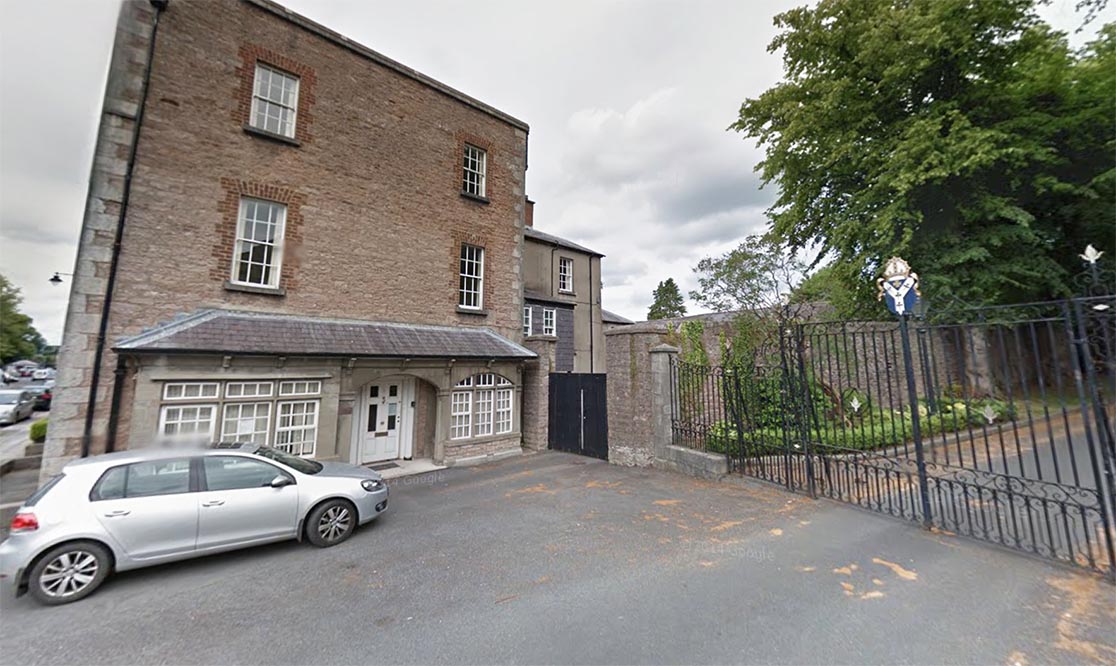
A landmark listed building on the Mall in Armagh is to be converted into apartments after a decision to refuse permission for the development was overturned on appeal.
ABC Council had rejected the Coyle Group’s proposals to develop the three-storey property at 5 St Mark’s Place.
The applicant had sought approval to create apartments. Outbuildings at the back, meanwhile, were to make way for new housing.
The proposals met with strong objections and were subsequently turned down by ABC Council in June 2024.
But despite the protestations of Armagh Orange Hall, St Mark’s Parish Church, the Mall Trustees and local residents, the decision to refuse the applicant the go-ahead has now been reversed.
The Planning Appeals Commission, having considered the facts before it, ruled that the project can proceed and have granted – subject to 23 conditions being met before and during works – approval to the Coyle Group.
The decision, by Commissioner Mandy Jones, comes after an informal hearing earlier in the year. Objections were heard by Bell Rolston Planning Consultants, with the applicant represented by Cleaver Fulton Rankin Solicitors.
The application first emerged in January 2021 – two years after plans to develop sheltered living accommodation on site had been advertised then subsequently withdrawn.
The Coyle Group had sought permission for the “restoration and change of use” of a listed building to provide three apartments and a bedsit.
In terms of the outbuildings to the rear – previously used as stables but converted to office space – the plan was for “change of use to two terraced houses and erection of two one-bed semi detached dwellings and one two-bed detached to rear of site with ancillary works”.
The main issues in the appeal were whether the proposal would provide a quality residential development; exhibit a density and pattern of development in keeping with the overall area; impact the lime trees within the Conservation Area; impact on features of natural heritage, namely priority species; provide a satisfactory means of dealing with sewerage associated with the development and provide a safe access and appropriate level of parking.
Council and objectors had argued that the proposals did “not conform to a number of criteria” in relation to residential development.
According to Commissioner Mandy Jones’ report: “The council’s concerns focus on the scheme layout in respect of the relationship between accessible dwelling 1 and the existing stables outbuilding, the relationship between accessible dwelling 2 and accessible dwelling 3 and overall landscaped and hard surfaced areas.
“Objectors’ concerns relate to the dominance of parking and hardstanding, lack of landscaped areas and that accessible dwellings 1 and 2 have substantially smaller plots which are out of character with the surrounding area, and refer in particular to Charlemont Gardens, which is characterised with detached dwellings set on generous plots.
“The council refer to Paragraph 7.12 of Creating Places ( CP ), which states that layouts that include dwellings and apartments facing onto the rear garden spaces of other dwellings (or that back onto the fronts of other dwellings) should be avoided. Such layouts generally provide an unsatisfactory relationship between dwellings, even where dual aspect designs are employed, and can adversely affect privacy, reduce safety and be detrimental to the quality, character and appearance of the development as a whole.”
But the Commissioner continues: “I am mindful that any assessment must be made in the context of this urban underused back land site within an existing housing zoning and Plan support for protecting existing established residential areas and the provision of new residential accommodation encouraged within Armagh central area.
“Whilst I acknowledge the cuncil’s reliance on Creating Places, I note it is supplementary planning guidance and not itself policy and should be applied in a flexible way, taking account the characteristics of development proposals and wider design constraints and opportunities.”
The Commissioner noted that “whilst accessible dwellings 1 and 2 have smaller plots than those on the adjacent development within Charlemont Gardens, given the separation distances involved, inter relationships and siting of these two dwellings in this urban back land setting, in close proximity to the extensive open space within the Mall, I do not consider these plot sizes to be unacceptable”.
In terms of the “dominance of parking and hardstanding areas”, Commissioner Jones said there were grassed areas in between which “offer the scope for further planting which can be required through a condition for a detailed landscaping plan”.
The official also found no “unacceptable” overlooking or separation distances as a result of the overall planned development.
Addressing further concerns, she continued: “Although car parking spaces are directly to the front elevation, wider views from the front windows are towards a larger courtyard area.
“However, to soften the aspect from the front elevation ground floor living area landscaping plans could include a planted buffer to this frontage which can be secured by condition.
“I consider the placement of ramps and planted buffers to the front elevation and planted areas to the rear elevation of the townhouses provide a defensive space for residents, which will ensure that these terraced dwellings are not surrounded by roads, as asserted by the objectors.
“The glare of car lights as drivers exit and enter the appeal site would not be to an unacceptable level, given the low level of vehicles accessing the appeal site and this urban location.”
The application was accompanied by an ‘acoustic design review’, which outlined “mitigations to be employed” to ensure future residents of 5 St Mark’s Place would not be “unduly affected by noise and that adjacent residents would not be unduly affected by noise from the appeal development”. It concluded that the proposed land use would “not conflict with the ecclesiastical land” – St Mark’s Parish Church property – to the south east.
But a number of objections referred to the impact of the development on the Orange Hall building, which was described as a “major focal point and cultural, social, entertainment and community venue in Armagh”.
Commissioner Jones’ report states: “They stated that the Orange Hall hosts events which end late at night and may cause disturbance in terms of noise, gathering of crowds, parking and access problems to the proposed residents which may endanger the use of the Hall.
“Objectors added that most recently the appeal building was used as office accommodation through working hours, which left the building vacant at night and holiday times.
“The historic use of the appeal site was residential – albeit a single dwelling – and there are existing residential uses around the site.
“No evidence of any noise complaints was submitted from any of the surrounding residential properties from activities within the Orange Hall, and I note Environmental Health has no concerns in this regard.
“I am not persuaded that the appeal proposal would jeopardise the existing and established use rights of the Orange Hall. I am satisfied that the proposed residential land use is compatible with the Orange Hall community building.”
In terms of concerns over trees, protected as they fall within the Conservation Area, the official said that a condition could be imposed requiring a ‘construction method statement’, to include how the trees and the root protection zones are to be protected during the construction process.
Objections in relation to housing density were also addressed then rejected, the Commissioner finding it to be “appropriate” and a development which “would not lead to town cramming”.
In relation to protected species, a full bat survey was carried out and submitted in June, which found the numbers of bats recorded to be “low considering there are so many mature trees and buildings in the area”.
The Commissioner said it was “imperative that there is no impact of the appeal development on protected species – in this case bats”.
To that end, she said the appointment of an ‘ecology clerk of works’ prior to development could see them undertake necessary checks and to oversee the removal of roof slates in preparation for renovation works; and method statements for the phasing of works to avoid bat roosting time during the summer months.
She said no bats were seen emerging from the buildings but, if there was a two year delay to the development, a “further emergent bat survey is recommended to ensure no change to the June 2025 survey”.
Conditions would also be put in place over the treatment of Japanese Knotwood on a “relatively small and localised area” near the rear wall of the site, and the development timed around its treatment.
Furthermore, concerns by council and objectors over sewage “can be overcome”, according to Commissioner Jones.
She said a planning condition was necessary which would prohibit any start to development until a wastewater impact assessment confirmed that a “sewerage connection can be made or that alternative provision for disposal of sewerage is made, and this is submitted to and agreed in writing by the planning authority”.
“This would ensure that the concerns raised by the council and objectors are addressed before any development proceeds,” she said, but cautioned the developer: “If no suitable solution could be found, then the development would not take place.”
On the matter of the potential for “conflict with visitors” to St Mark’s Church, the Commissioner pointed to the fact that there are two accesses – from the Mall and from Victoria Street.
She continued: “Even if there was some conflict with the residential users of the site and visitors to the church, given this has been significantly reduced from the former office use of the appeal site and provides betterment, I am not persuaded that any remaining low-level conflict is such to justify refusal of planning approval in road safety terms.
“I am not persuaded that the access would prejudice road safety or significantly inconvenience the flow of traffic.
“Objectors refer to additional car trips by carers to the site. I accept that any carers visiting the site may at be off peak times due to early morning and evening shift patterns and, in any case, could avail of the on-street parking along the Mall.”
On the issue of parking, while accepting that there was a shortfall, the Commissioner reported: “Due to this highly accessible urban location well served by public transport, proximity of the bus centre, types of tenants and on-street parking with spare capacity along the Mall, I consider the provision of parking spaces to be broadly acceptable.
“Although there are no designated visitor parking spaces within the appeal site, again visitors can avail of the spare capacity within the on-street parking on the Mall.”
Commissioner Jones concluded that the council’s reasons for refusal and objectors’ concerns had “not been sustained” and, therefore, “the appeal is allowed”, subject to the applicant meeting the requirements of 23 conditions laid down.






